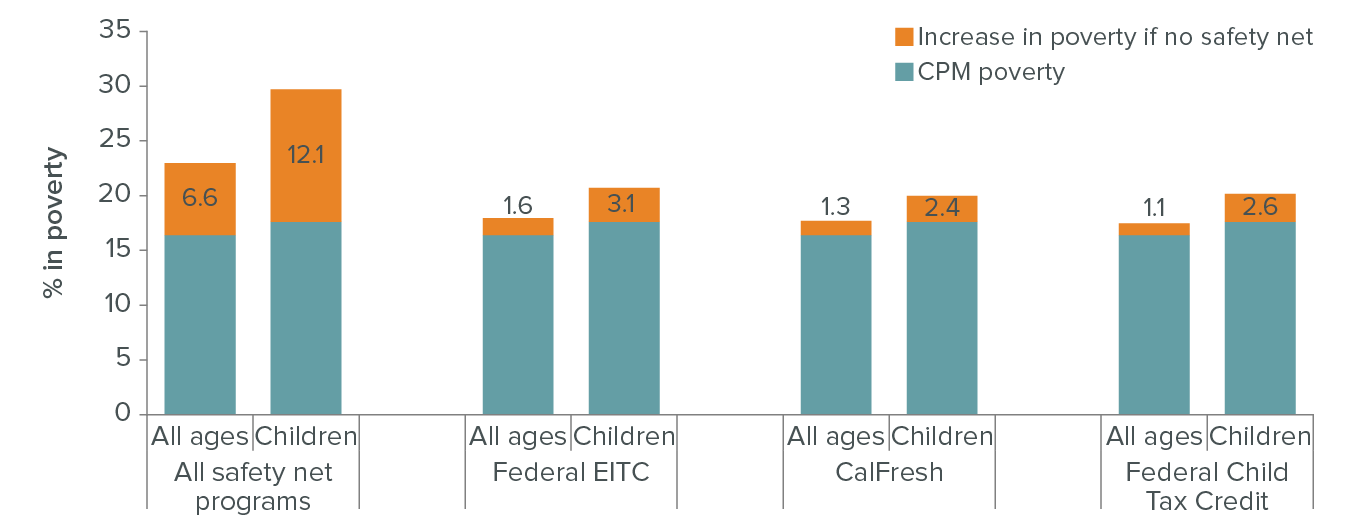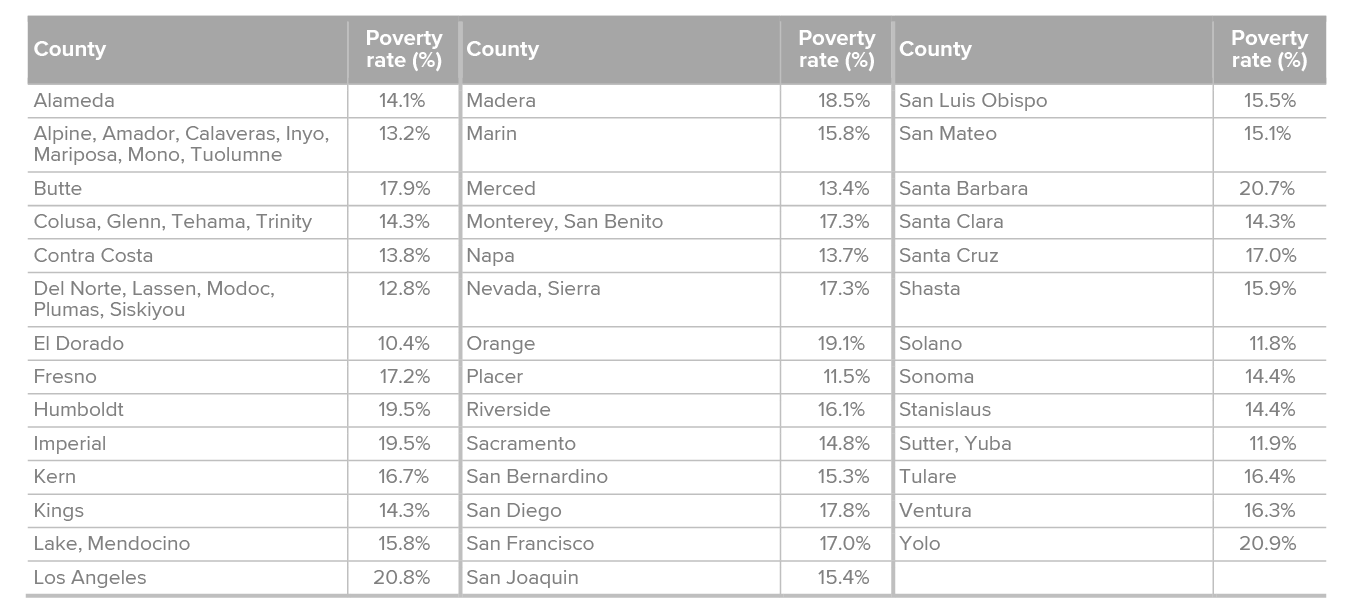Alifornia Ranks No 1 in Poverty Once Again
This year's California Poverty Measure estimates describe poverty in 2019—using the nearly upwardly-to-date data available—so do not embrace the economic impact of COVID-nineteen or subsequent policies.
- Poverty in California declined in 2019, but the effects of COVID-nineteen are still uncertain.
Unlike the official poverty measure, the California Poverty Measure (CPM), a joint research effort by PPIC and the Stanford Center on Poverty and Inequality, accounts for the toll of living and a range of family needs and resources, including prophylactic internet benefits. According to the CPM, sixteen.4% of Californians (about 6.3 million) lacked plenty resource—$35,600 per year for a family of four, on boilerplate—to meet basic needs in 2019. The poverty rate dropped from 17.six% in 2018. In 2020, COVID-19 is likely to accept increased poverty due to severely constrained employment opportunity. All the same, state and federal responses like the CARES Act in 2020 and the American Rescue Plan Act (ARPA) in 2021 could have mitigated poverty surges by providing economical support. - More than a third of Californians are living in or near poverty.
Virtually one in six (xvi.4%) Californians were non in poverty just lived fairly close to the poverty line (up to one and a half times above it). All told, more than a third (34.0%) of state residents were poor or near poor in 2019. The share of Californians in families with less than one-half the resources needed to meet bones needs (the deep poverty rate) was four.6%. - Without social safety net programs, more than Californians would alive in poverty.
Without the largest social safety net programs, we estimate 6.6% more Californians would accept been in poverty in 2019. Almost condom net programs are designed to prioritize children, and in 2019 they kept 12.1% of children out of poverty. The federal Earned Income Taxation Credit (EITC) lowered poverty rates about, past 1.6 points overall, and CalFresh lowered the overall poverty rate by ane.3 points. The federal Child Tax Credit (CTC) lowered the charge per unit by 1.i points; CalWORKs and General Assistance (GA) together lowered the rate by 0.eight points. Amidst children nether age 6, the combined California EITC and Young Child Tax Credit (YCTC) lowered the rate by 0.six points. These differing effects reflect program scale and scope also as participation rates among eligible families.
Poverty would exist even college without the safe net, especially amid children

SOURCE: Estimates from the 2019 CPM.
NOTES: "Increase in poverty if no rubber cyberspace" segments prove the estimated increase to the poverty rate if safety net resources are not counted. Programme effects may overlap and are not only additive. Children are ages 0–17. "All safety net programs" includes CalFresh (California's Supplemental Nutrition Assistance Plan), CalWORKs (California's Temporary Help for Needy Families program), federal and state Earned Income Tax Credits (EITC), the state Young Kid Tax Credit (YCTC), the federal Child Tax Credit, Supplemental Security Income (SSI/SSP), General Help (GA), federal housing subsidies, the Supplemental Nutrition Program for Women, Infants, and Children (WIC), and school meals.
- Poverty rates and the effect of safety cyberspace programs vary widely across the state.
Yolo (20.ix%) and Los Angeles (20.8%) Counties had the highest poverty rates (2017–2019 average). El Dorado County had the everyman rate, at ten.iv%. Rates vary fifty-fifty more widely (v.1% to xl.three%) across local areas and legislative districts. Safety internet programs reduce poverty much more than in inland areas: without them, poverty would be 12.1 points higher in the Cardinal Valley and Sierra, but only 3.1 points college in the Bay Area.
Poverty rates vary widely across California's counties

SOURCE: Estimates from the 2017–2019 CPM combined.
NOTES: For some counties, poverty rates cannot be calculated individually. Those counties are grouped. All estimates are subject area to incertitude due to sampling variability. The uncertainty is greater for less-populous counties and county groups (because of smaller survey sample sizes). The statewide margin of error is ±0.4 percentage points. The median county margin of error is ±2.0 per centum points. Margins of fault calculated for a 99% conviction interval. For more county-level information and poverty rates by local area and state assembly, state senate, and federal congressional district, see our interactive maps.
- Poverty remains college amidst children, seniors, Latinos, and less-educated adults.
Poverty rates vary dramatically across demographic groups. In 2019, adults 65 and older (18.0%) and children (17.6%) had higher rates of poverty than adults age 18–64 (15.six%). The poverty rate for immigrant Californians was 21.6%, compared to 14.iv% for non-immigrants, and poverty amongst undocumented immigrants was 35.7%. More than i in five (21.four%) Latinos lived in poverty, compared to 17.4% of African Americans, xiv.5% of Asian Americans/Pacific Islanders, and 12.1% of whites. Though the Latino poverty charge per unit has fallen from 30.nine% in 2011, Latinos remain disproportionately poor—comprising 51.vi% of poor Californians but only 39.7% of the country population. Poverty was 7.two% among college graduates historic period 25–64 and 29.ane% among adults age 25–64 without a high school diploma. - Most poor families in California are working.
In 2019, about fourscore.0% of poor Californians lived in families with at least i working adult, excluding families made up of adults age 65 and older. For 46.8% of those in poverty, at least one family member reported working full fourth dimension for the entire yr, while 32.4% had a family member who worked part fourth dimension and/or part of the year.
Topics
Economic system Health & Prophylactic Net Immigrants in California Population Poverty & Inequalitysebastiansully1963.blogspot.com
Source: https://www.ppic.org/publication/poverty-in-california/
0 Response to "Alifornia Ranks No 1 in Poverty Once Again"
Post a Comment